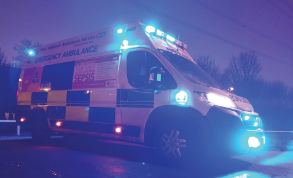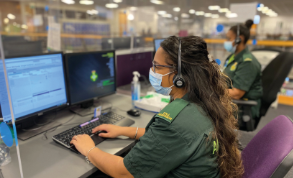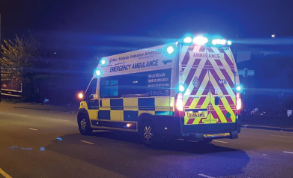Feature / Emergency response
Acute hospitals are clearly at the centre of the NHS recovery programme, with a huge elective waiting list to manage. But, less obviously perhaps, ambulance services will also have a major role to play in eliminating the backlog.
‘The ambulance sector is key to enabling the elective recovery,’ says Claire Finn, director of finance at West Midlands Ambulance Service University NHS Foundation Trust. ‘We won’t be able to recover at all if patients are continuing to present at accident and emergency [in their current numbers], while hospitals are unable to get patients discharged.’
Although there is understandably a focus on hospitals, the solution is not just about running the acute sector faster. There must also be a focus on addressing upfront demand for acute services and the discharge process. And Ms Finn believes that the ambulance sector’s contribution is sometimes overlooked. This can be through increasing the amount of treatment delivered on the scene – avoiding the need for conveyance – or it could be by directing or delivering patients directly to a more appropriate service.
Pandemic challenges
Ambulance services have had their own challenges during the past 18 months as part of the response to Covid-19. They faced similar staffing challenges to those seen across the NHS as staff either caught the virus themselves – around one in five tested positive in the West Midlands trust – or were required to isolate because of close contact with the virus.
The trust puts a major premium on staff training – an approach reflected in its university trust status. As part of this it provides extensive training for paramedics through placements connected with Wolverhampton, Worcester, Birmingham, Staffordshire, Birmingham City and Coventry universities. At any one time, the trust can have up to 1,000 students working with it.
As a result, the trust had a head start when it had to rapidly increase workforce numbers during the pandemic. Some 400 net additional ambulance staff were taken on in different roles, including students who were deployed early and others working with non-emergency patient transport services (PTS).
It was not just staff on ambulances that were needed, but also call handlers too, for both emergency and 111 services.
While there were periods during 2020 when activity fell for the ambulance trust, demand has come flooding back.
‘As I joined the trust in February this year, demand was rapidly growing for both 9s and 1s,’ says Ms Finn. ‘Pre-pandemic, 111 call volume was around 1.2 million a year – but [by the start of the year] it was at 1.8 million and is now heading for two million.’ Despite the trust working to a block contract and so not having the financial commitment to expand, it needed to commit to recruitment.
‘Our 111 service is so much more than a call centre,’ she continues. ‘The service has clinicians, pharmacists and mental health advisers, which are really difficult positions to recruit to given the shortages in these areas anyway. Our call handlers are band 3 roles, so not particularly highly paid, but are dealing with people either in crisis or frustrated at not having been able to access primary care. They are working in a consistently stressful environment, taking call after call, so retention is understandably difficult.’
The trust has merged its emergency and 111 centres (pictured) with call handlers who are now trained to handle both types of call – giving much more flexibility on staffing arrangements and enabling better triage of calls.
Recruitment push
In the ongoing recruitment plan, the trust looked to appoint some 300 call handlers and around 100 clinicians, and the recruitment programme is continuing. Amazingly, the trust is one of the few trusts not to use agency staff to fill vacancies – and has continued this throughout its Covid response, avoiding the accompanying premium costs.
On top of the increase in 111 traffic, the trust has been seeing 999 demand running at 10% higher than pre-Covid levels. And, like most ambulance services at the moment, West Midlands’ biggest risk area relates to patient handover delays.
In October, services in England as a whole failed to meet the response time standard for the most urgent life-threatening incidents of getting to calls in an average of seven minutes and 90% of calls in 15 minutes – instead delivering a mean average response time of nine minutes 20 seconds. For category 2 emergency calls, the average response was nearly 54 minutes compared with the standard of 18 minutes and 40 minutes for 90% of calls.
Meanwhile, the service has had to deal with handover delays of up to 14 hours for some patients, despite a national standard of handing the patient over in 15 minutes. A clinical review undertaken by the Association of Ambulance Chief Executives on delayed handovers suggested that eight out of 10 of delays over 60 minutes were likely to inflict some level of harm on the patient.
The damage doesn’t stop there; it also unnecessarily ties up the ambulance and its crew, keeping them off the road and potentially delaying a response for other patients. Lengthy handovers at hospital can also push paramedics into overtime, adding a financial cost too.
Ms Finn (pictured) says the position will inevitably become more challenging over the winter months. But she says the solution lies in system-wide change. And she is clear that penalties on hospitals – which existed under pre-pandemic activity-based contracts – are not the answer. ‘We can only resolve this by working together on the most appropriate model of care,’ she says.
There are things that the ambulance trust can do. Its ‘see and treat’ and ‘hear and treat’ percentages are both up significantly, and in overall terms, its conveyance rates are down.
‘We are ensuring we are treating many more patients in their own homes and we have a clinical validation team that can signpost patients to services other than A&E where appropriate,’ Ms Finn says.
Added complexity
The problem is complex. There is a role for more capacity in hospitals – involving more staff and beds and faster discharge. ‘But the profile of patient demand is so different to pre-pandemic,’ she says. ‘That is both in terms of volume and, in some cases, complexity.’
The increased emergency demand is not only about Covid patients; the trust is also seeing the consequences of patients not accessing NHS services while social distancing restrictions were in place.
‘Can primary care impact on the level of demand we are seeing for 111 and 999?’ Ms Finn asks, acknowledging that general practice is also facing significant pressure. ‘Or, if this is the new normal, we need to look at different ways to manage, otherwise we will continue to see this bottlenecking the whole system.’
Funding for social care is key to faster discharge from hospital for medically fit patients and freeing up much needed capacity, which can help reduce pressure and waits at the front door. But Ms Finn says that patient transport services also have a part to play.
But while West Midlands Ambulance Service provides PTS services for many systems across its region, not all ambulance trusts are able to offer such a service.
Having the PTS capacity helped massively during the pandemic as the trust was able to deploy some of its PTS staff into its emergency and urgent care work to support the Covid response. But, says Ms Finn, PTS can only take on its full role in the recovery if the service is resourced to have the right capacity. In general, she is concerned that the potential for the ambulance service to support wider recovery is not reflected in current funding arrangements such as the Targeted Investment Fund, which is firmly focused on the acute sector.
Further, she says that proposals to have paramedics within primary care networks need to take into account the finite pool of paramedics that the NHS is drawing on – or recognise the time needed to increase the size of that pool.
Integrated view
All of this points towards a bigger role for systems in taking a whole pathway view. However, as Ms Finn points out, integrated care systems are still in the evolution phase and ambulance trusts typically sit across multiple systems.
‘In the West Midlands, we work across six systems, but we are hosted by just one – Black Country and West Birmingham,’ she says. ‘So how do we ensure there is a voice and a proper consideration of the ambulance sector across all six? We have some great ideas within the service, but how do we take this forward across systems with different priorities and challenges?’
She says the way system financial envelopes have been allocated creates challenges. For example, funding should have been allocated to ambulance trusts as part of the Mental Health Investment Standard (MHIS),
especially because mental health issues have been a big part of the increase in demand over the past 18 months. But the growth funding for mental health services dictated by the MHIS doesn’t necessarily get mirrored in ambulance trust contracts.
As with the whole NHS, the current temporary funding system based on block contracts – which has provided welcome stability during the pandemic – is masking the real underlying financial position for many organisations.
The £400m-turnover West Midland’s trust delivered its required break-even for the first half of 2021/22, thanks to additional system funding of £2.2m and some additional funding for 111 services. But this also relied on £22m of non-recurrent income.
A full-year balanced position will need £55m of non-recurrent funds, taking into account additional costs for 111 and winter pressures. And that pressure will carry into next year when the current temporary financial regime comes to an end. ‘How do we get this recurrently for 2022/23 when it will be very difficult to switch off any of the costs that we have got in the system?’ Ms Finn asks.
Even a return to the pre-pandemic payment by results system would not fix this gap. If the trust had been paid for the first six months under the old regime, it would have received a further £8m (which wouldn’t have included the 111 service) – well short of its gap in recurrent funding. And in any case, the service is not returning to the national tariff system.
‘We need to reset the contract baseline,’ says Ms Finn. ‘Clearly, just like all organisations, we will have to deliver an efficiency requirement with a trajectory built in, but we can only do that if we have got certainty over the level of recurrent funding.’
The proposals for an aligned payment and incentive system allow for setting activity based on realistic projections rather than historical contract levels and also encourage contracts to be informed by costs and not price.
However, she acknowledges that affordability will inevitably play a part for the system commissioners – although there is an understanding within the finance community across the systems over the challenges that the trust is facing. ‘The settlement for the next few years here will be key, along with a decision about how much funding can go into the ambulance sector,’ she says.
The current ambulance handover delays outside hospitals are a symptom of an NHS under extreme pressure. The solutions are complex and will need to be across complete patient pathways. But there also needs to be a better understanding of the expanding role ambulance services can play as part of that system solution.
Fleet concerns
West Midlands Ambulance Service has a fleet of more than 1,000 vehicles, including emergency and patient transport ambulances and specialist resources. No vehicle is older than five years. And Ms Finn says this relatively young fleet, along with a proactive recruitment process, meant the trust was in good shape heading into the pandemic and contributed to the trust’s ability to meet all the national performance standards last year.
‘Having a modern fleet keeps our maintenance and breakdowns fairly minimal,’ she says, avoiding knock-on consequences in terms of response times and revenue costs. But she has concerns about being able to access sufficient capital resources to maintain this, while also helping to deliver the ambitions of the NHS net-zero commitment.
This year’s £16.6m capital programme has been reduced to £15.6m to help the system stay within its capital envelope. ‘When the acute and mental health providers have got such significant backlog maintenance or the need to invest in high priority clinical equipment, how do we prioritise the ambulance sector? The system is making a decision on behalf of the region about how much capital we get and that will impact on our fleet replacement programme and our estates strategy,’ she says. ‘So, I would like to see the capital being dealt with differently going forward.’
The trust is also committed to carbon reduction, and has already almost halved carbon dioxide emissions by reducing the size of its estate from 149 sites to just 46. And it became the first trust in the country to introduce a fully 100% electric ambulance during 2020.
Related content
We are excited to bring you a fun packed Eastern Branch Conference in 2025 over three days.
This event is for those that will benefit from an overview of costing in the NHS or those new to costing and will cover why we cost and the processes.